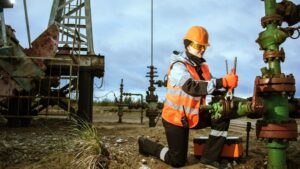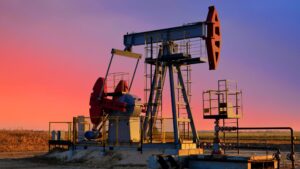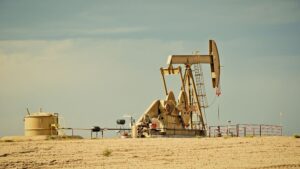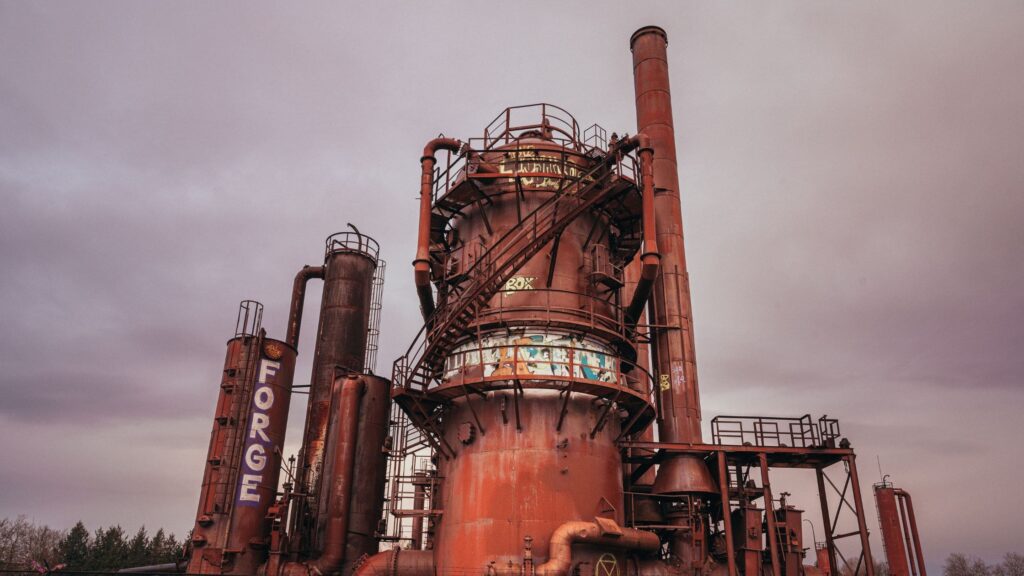This article aims to shed light on the essential roles, operations, and intricacies of the midstream segment.
What Exactly is Midstream in Oil and Gas?
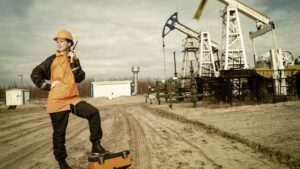
Midstream refers to the various processes involved in transporting and processing raw natural gas and crude oil.
Situated between the upstream (mineral exploration and extraction and oil and gas production) and downstream (refining and marketing) sectors, midstream ensures a seamless flow of operations across the oil and gas value chain.
Why is the Midstream Sector Crucial?
- Ensuring uninterrupted supply to downstream companies.
- Reducing transportation and processing costs for oil and gas companies.
- Enhancing the value of raw materials by transforming them into refined products.
- Facilitating a steady flow of energy to meet global demand.
How Does the Midstream Process Work?
The midstream operations encompass several key stages:
Gathering and Processing
The raw materials in the oil and gas industry are not immediately ready for use upon extraction. When raw crude oil and natural gas surge from the ground, they often come intertwined. The initial process of separating raw gas from oil takes place in the gathering and processing stage. This process doesn’t merely involve separation; it’s about refining raw materials into a more marketable form. A primary concern here is contaminants. For instance, the raw natural gas might contain elements like:
- Water: It can corrode pipelines and lower the quality of natural gas.
- Hydrogen sulfide: A harmful compound to humans and detrimental for pipelines.
- Volatile organic compounds: Such compounds can harm both the environment and individuals.
Post separation, the natural gas is further processed into consumer-ready products like methane and ethane. These products are vital feedstock for various industries and are essential for power and heat generation for communities worldwide.
Stabilization
Transporting crude oil is not as simple as loading it into a vessel and sending it off. There’s an intricate process that precedes this, often referred to as stabilization. Raw crude oil is a mixture of several hydrocarbons. Stabilization ensures that lighter hydrocarbons are extracted from the mixture. Why is this necessary? By doing so, it:
- Reduces the volatility of the oil, making it safer during transportation.
- Prevents the potential release of harmful emissions.
- Ensures a uniform quality of oil being transported to refineries or storage facilities.
Transportation of Oil and Gas
With the vast expanses between production sites and refineries or markets downstream, the midstream industry faces the challenge of transporting vast quantities of oil and natural gas across great distances. The infrastructure required is immense, and the transportation methods are varied:
- Pipelines: The most common means, especially for transporting oil over vast territories. The oil pipeline system is extensive and highly regulated to ensure safety and efficiency.
- Trucks: Ideal for shorter distances, especially in areas where pipeline infrastructure might be lacking.
- Tankers: Perfect for transporting oil and gas across oceans to international markets. For instance, offshore oil, once extracted, might need to be moved to refineries located in another part of the world.
- Rail: An alternative to pipelines and trucks, especially when terrain or geopolitical issues pose a challenge.
Transportation not only requires physical assets but also strategic planning, as factors such as demand, geopolitical scenarios, and even weather can influence transport decisions.
Storage and Wholesale Marketing
Once oil and natural gas are processed, they don’t immediately find their way to end-users. There’s often a temporal gap between production and consumption. Hence, the role of storage facilities becomes paramount. These aren’t just vast tanks or reservoirs but strategically located assets that ensure:
- A steady supply to meet market fluctuations and demand.
- Optimal conditions to store different petroleum products, considering factors like temperature, pressure, and more.
Apart from storing, the midstream industry also engages in wholesale marketing. This phase is essential as it connects oil and gas producers with downstream companies or end-users. For instance, the produced oil might be sold to refineries, which in turn process it into gasoline, diesel, and other refined petroleum products for consumers.
Navigating the midstream sector requires expertise and strategic planning. Whether it’s ensuring the safe transportation of oil via interstate pipelines or managing storage capacity efficiently, companies like Magellan Midstream Partners and Williams Companies have showcased success in optimizing midstream operations.
What Infrastructure is Found in the Midstream Sector?
The midstream industry heavily depends on its infrastructure.
Its infrastructure plays a pivotal role in this journey, keeping the oil and gas industry’s operations running smoothly.
Pipelines
A linchpin of the midstream sector, pipelines are the primary mode of transportation, ensuring that crude oil, natural gas liquids, and raw natural gas are efficiently transported. Pipelines can be onshore, crossing vast stretches of land, or offshore, connecting deep-sea production sites to mainland facilities.
Challenges related to leaks, emissions, and volatile organic compounds persist. These have catalyzed innovations in pipeline technology, ensuring that these pipelines are safer and more efficient.
- Interstate Pipelines: Responsible for moving oil and gas across state lines and often countries, ensuring the product reaches major storage and distribution hubs.
- Gathering Systems: These are smaller pipelines connecting the production sites, or wells, to the main pipeline transportation network.
Storage Tanks
Integral to the midstream oil and gas operations, storage tanks are facilities where both crude oil and processed products are stored, ensuring a continuous supply chain. These structures come in various forms:
- Ground-level Reservoirs: Massive tanks primarily used for storing raw crude oil.
- Elevated Tanks: Typically store refined petroleum products ready for distribution.
Compression Stations
For the gas industry, these are the heartbeat. They maintain the movement of gas through pipelines by increasing its pressure. As raw natural gas travels through pipelines, its pressure tends to drop. These stations step in to increase the pressure, ensuring a steady gas stream flows towards its destination.
- Gas Processing Units: Before natural gas can be transported, it needs to be processed to remove contaminants like hydrogen sulfide and carbon dioxide. These units help convert raw natural gas into marketable products.
What Are the Risks Associated with the Midstream Sector?
While the midstream sector plays an undeniably essential role in the oil and gas industry, it doesn’t come without its set of challenges. These hurdles often pose risks to midstream operations, impacting both the environment and the business infrastructure.
Environmental Concerns
The crisscrossing network of pipelines presents environmental challenges. There’s a constant risk of spills and leaks which can have detrimental effects on the surrounding environment. Furthermore, emissions, including methane and carbon dioxide, can contribute to global warming.
- Water Contamination: Produced water, a byproduct of extracting oil and natural gas, can pose risks if not treated and disposed of correctly.
- Land Use: The construction and maintenance of pipelines and storage facilities might disrupt natural habitats and communities.
Technological and Operational Risks
The midstream industry relies heavily on complex machinery and systems. These, however, can be vulnerable to a range of disruptions:
- Equipment Failures: From pipelines to storage tanks, equipment can malfunction. For example, untreated natural gas, which may contain hydrogen sulfide, can corrode pipelines.
- Human Errors: Even with the most advanced technology, human intervention is a necessity. But with this comes the risk of errors which can lead to potential catastrophes.
- Technical Glitches: The integration of modern technologies means that software and other system glitches can interrupt operations.
Moreover, many large oil companies have diversified operations, which means they operate across the upstream, midstream, and downstream segments. A disruption in the midstream operations can have ripple effects on the downstream operations, where the oil and natural gas are refined into consumable products. This interconnectedness makes managing risks in the midstream sector even more critical.
How is Safety Ensured in Midstream Operations?
Safety is at the pinnacle of priorities in the midstream sector. Within the oil and gas industry, safety standards and protocols are strictly enforced to protect both the environment and the people who work within this space.
Midstream operations, sandwiched between upstream and downstream sectors, primarily focus on the processing, transportation, and storage of petroleum and natural gas. As they play a pivotal role in ensuring that these products reach their end users safely, their safety protocols need to be impeccable.
Monitoring and Detection Systems
Harnessing advanced technology, the midstream sector emphasizes the importance of timely detection of potential threats. It’s not just about averting economic losses; it’s about preserving the environment and ensuring worker safety. Advanced systems have been developed to:
- Leak Detection: Using sensors throughout oil pipeline systems, leaks can be swiftly detected. This is critical, especially for natural gas liquids, as any leakage can lead to emissions of volatile organic compounds.
- Carbon Dioxide and Hydrogen Sulfide Monitoring: These potentially hazardous gases can be byproducts in gas processing. Real-time monitors ensure that their concentrations remain within safe limits.
- Pressure and Temperature Checks: Many oil and gas processes work under higher pressure. Monitoring these conditions prevents system breaches and ensures stability.
Training and Certification for Midstream Personnel
It’s not enough to have top-notch equipment if the people operating them aren’t equally competent. The midstream industry ensures that:
- Rigorous Training Regimes: Every individual working in the sector undergoes intensive training. This isn’t limited to their specific job role but encompasses an overall understanding of the midstream operations.
- Certification Standards: Before being allowed to operate, individuals need to be certified, showcasing their knowledge and skills related to the oil and gas industry. This makes certain that the industry’s high standards are upheld.
- Periodic Refreshers: The world of oil and natural gas is always evolving. As such, even the most experienced personnel are periodically updated on new safety standards, equipment, and methodologies.
How Does Midstream Economics Work?
When diving into the realm of midstream economics, it’s a delicate balance of understanding the dynamics of supply and demand, global oil market fluctuations, and the intricate details of transportation and storage costs. The midstream industry is intricately woven into the larger fabric of the global oil and gas industry.
Tariffs and Pricing Structures
How much does it cost to transport oil across a continent or to store natural gas for a season? Pricing is more complex than just calculating distances. It involves:
- Distance and Quantity: The farther the transport, the higher the cost. Additionally, transporting larger quantities might fetch volume discounts.
- Market Demand: Tariffs can surge during peak demand, for instance, in winter for natural gas.
- Infrastructure and Maintenance Costs: Maintaining pipeline transportation systems, storage facilities, and processing plants isn’t cheap. These costs factor into the tariffs.
- Regulatory Costs: The midstream sector is highly regulated. Complying with these regulations involves costs which are often passed on to the end users.
Key Market Drivers and Challenges
The pulse of the midstream industry is invariably connected to global events. Whether it’s geopolitical tensions affecting crude oil prices or a sudden boom in natural gas production in a specific region, midstream operations must be agile. They face:
- Supply-Demand Dynamics: The basic economics of supply and demand always hold. An increase in natural gas production in Canada, for example, can flood the market, affecting midstream tariffs.
- Geopolitical Tensions: Global events, like sanctions on oil and gas companies or disruptions due to conflicts, can throw the best-laid plans into chaos.
- Technological Advancements: As the industry evolves, so do the challenges and opportunities. New extraction and processing techniques can redefine the economics.
- Environmental Regulations: Stringent rules on emissions, drilling, and transportation can influence operational costs.
How is the Midstream Sector Regulated?
The midstream industry is highly regulated:
- Regulatory bodies oversee safety, pricing, and environmental concerns.
- Companies are obligated to report, monitor, and adhere to strict guidelines.
What Future Innovations are Expected in the Midstream Sector?
The midstream sector is on the cusp of a digital revolution:
- Digitization and Automation: From AI-driven operations to IoT-enabled pipelines, digital solutions are transforming midstream processes.
- Sustainability and Environmental Measures: Innovations focus on reducing the carbon footprint, with green technologies taking center stage.
How to Start a Career in the Midstream Sector?
For those keen on a career in midstream.
Qualifications and Educational Prerequisites
Before diving into the midstream sector, it’s imperative to know the qualifications. Notably:
- Most positions necessitate a background in petroleum engineering, business, or related fields.
- Understanding the basics of crude oil and natural gas production is a plus.
- Hands-on experience, such as internships with oil and gas companies, can set you apart in this competitive market.
Career Trajectories and Job Roles
The midstream sector is diverse, encompassing a range of roles:
- Pipeline operators: Those who manage the oil pipeline system, ensuring efficient transportation of crude oil and natural gas.
- Gas processing engineers: Professionals responsible for converting raw natural gas into marketable products, removing contaminants like hydrogen sulfide and volatile organic compounds.
- Storage facility managers: Individuals who oversee storage facilities, ensuring the safe and efficient storage of produced oil and gas.
How Does Midstream Interact with Upstream and Downstream?
The midstream sector serves as the bridge between the extraction (upstream) and refining/distribution (downstream) segments of the oil and gas industry.
The fluidity between upstream, midstream, and downstream sectors ensures a seamless supply chain. Here’s a snapshot:
- Upstream oil and gas involves exploration and drilling for oil and natural gas. Once extracted, these products need transporting and processing.
- Midstream: Steps in to transport oil and gas from the wellhead, process them, and store them for downstream companies.
- The Downstream oil and gas sector takes the refined products from midstream and converts them into finished end products like gasoline, diesel, and other petrochemicals for end users.
The collaboration is evident, for example, in integrated oil and gas companies like Shell and BP. These global giants operate in all three sectors, demonstrating the interconnectedness of the oil and natural gas industry.
Notable Companies in the Midstream Industry
Given the sector’s importance, many large oil companies focus extensively on midstream operations:
- Magellan Midstream Partners: A leader in the midstream industry, renowned for its vast pipeline transportation system.
- Williams Companies: Another pivotal player, known for its extensive midstream assets, especially in gas segments.
Conclusion
The midstream sector, with its vast infrastructure and operations, stands as the linchpin in the oil and gas industry. From ensuring the transportation and processing of raw crude oil to delivering refined products to markets downstream, the midstream segment is indispensable.
As technological advancements continue to redefine its operations, the midstream sector’s role remains pivotal in powering the world.

